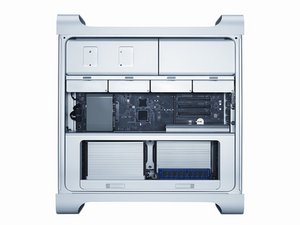@iammadfay start with this:
No Video
Unlikely cause: Power supply, fans, speaker, AirPort card, Bluetooth card
Symptoms:
- No Video
- No power perceived
- No video
- Dim video
Quick Check
1. To prevent replacing graphics cards unnecessarily, refer to http://support.apple.com/kb/HT4279.
Note that graphics cards have three ports. However, if using more than one Mini Display-Port to Single-Link DVI adapter, only two displays are supported across the three ports. (Three displays are supported if using Mini Display-Port to Dual-Link DVI adapters or Mini Display-Port to VGA adapters.)
2. Reseat all DIMMs. Refer to Memory Diagnostic LEDs.
3. Attach a known good and compatible DVI or Mini-DP monitor to computer’s video card. Verify video cables and connectors are free from defects (including bent pins). Verify power booster cable(s) are secured to the video card.
4. Power OFF/ON the display.
5. Verify the video card is supported in this computer. Previous model Mac Pro video cards may not be compatible. Cross reference the EEE Code and GSX part number.
6. Reset RTC.
7. Confirm at least one known good and compatible memory DIMM is installed in the computer.
8. After power ON, verify front panel power/sleep LED illuminated and is not flashing any error sequences indicating a memory failure. Caps Lock LED illuminates when CapsLock key is pressed.
9. Verify the computer is alive by listening for the drive booting sounds. If not detected go to Power, but No Boot Quick Check.
10. Remove non essential peripheral cards
11. Reseat video card (and power boost cable(s) if required) in the correct PCIe slot
12. Remove onboard backup battery.
Deep Dive
1. Disconnect all internal drives. Attach a known good display to the video card. Power ON the computer and verify video is observed on the display.
Yes - Video observed. Go to step 2.
No - No video observed. Go to step 3.
2. Verify the video quality observed is OK
Yes - Video quality OK. Go to step 5.
No - Video has poor quality, e.g. dim, distorted, etc. Go to step
4. Reset SMC and PRAM. Reseat memory, processor tray, video card. Verify video is observed.
Yes - Video observed. Go to step 2.
No - Move the video card into PCIe slot #2 to determine if backplane board PCIe slot #1 is defective. Retest. If video observed in PCIe slot #2, replace backplane board. If no video observed in PCIe slot#2, replace video card. Alternate: Go to step 7.
4. Reset SMC and PRAM. Reseat memory, processor tray, video card. Verify video quality observed is OK.
Yes - Go to step 5.
No - Replace video card. Alternate: Go to step 7.
5. Reconnect an internal boot drive. Allow the computer to boot (video software drivers will load). Verify video quality is OK
Yes - Video quality observed is OK. Problem maybe with the customer display, or the customer display may not be compatible.
No - Video quality problem evident after booting. Verify video card fan operating, and is not clogged with dust preventing adequate cooling.
Go to step 6.
6. Boot from known good and compatible Mac OS X. Verify video quality observed is OK.
Yes - Video quality observed is OK. Problem isolated to software. Clean install the customer hard drive with known good compatible Mac OS X or use the media supplied with the computer.
No - Move the video card into PCIe slot #2 to determine if backplane board PCIe slot #1 is defective. Retest. If video quality OK in PCIe slot #2, replace backplane board. If still poor quality in PCIe slot #2, replace video card.
7. For testing, dual-processor computers require only one processor installed in socket A. For dual- and single- processor computers, reseat processor in socket A. Verify video observed.
Yes - Go to step 2.
No - Go to step 8.
8. If dual-processor computer, swap out processor in socket A and retest. Verify video is observed.
Yes - Replace defective processor.
No - Replace processor board.
Let us know what you find on the individual steps.


 1,1k
1,1k  893
893  2,3k
2,3k